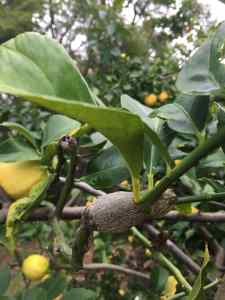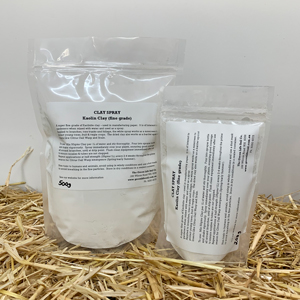| item(s), Total: $0.00 View Cart |
| Shopping cart is empty. |
Citrus Gall Wasp

This pest (native to the Eastern States of Australia) was first discovered in Perth in 2013, and unfortunately has been spreading since - despite efforts by gardeners and the Ag Department to eradicate it. If you grow any citrus fruit, keep an eye on the stems of your trees for swollen lumps (or galls) - as this is a sign that your tree has been attacked.
The lifecycle of Gall Wasp
The wasp produces a single generation each year, spending 95% of its life as larvae, its growth and development happens inside galls in branches. Understanding the lifecycle of these wasps will help inform what control option to use, and when.
Adult wasps emerge from galls in spring (September to December), when environmental conditions are suitable. Emergence is strongly associated with the spring growth flush. Adults are small (2.5mm), shiny black wasps, that live for 3 – 7 days, depending on temperature. Females can lay up to 100 eggs in this time. Egg laying starts immediately after wasps emerge with most laid within the first three days.
Eggs are laid under the bark of new season citrus shoots. They are less than 0.5mm, oval shaped, white, and slightly opaque, hatching in 2-4 weeks.
Larvae then burrow into the bark for 9–10 months. Woody tissue forms around the larvae causing the distinctive swelling of the gall. By the following winter, the larvae inside the gall pupate ready to emerge again as adults in spring.
The adult wasps don't have a large flying distance, although they can be carried by wind. So keeping on top of Gall Wasp in your neighbourhood is important. If your neighbours have citrus trees, work together to monitor and eradicate the pest if you can.
The main method of control is pruning out the affected branches and shredding, solarising or burning the off-cuts to make sure the larvae contained in the galls are destroyed (if composted, there's a chance they can survive). The best time to inspect and prune off galls is April to June. At this stage, you can safely dispose of the affected material in your rubbish bin, as the larvae are too small to survive. However, if you leave it until July or onwards, you need to solarise or burn the material. (Solarise by placing material in a well sealed plastic bag, and leaving in the sun for a minimum of four weeks.) If left untreated, in Spring the larvae will emerge from the galls and begin their life as adults. Holes in the galls indicate that has already happened, and you're too late to destroy this generation.
Originally, it was suggested that taking a potato peeler to galls can expose and kill the larvae, however testing has shown this to be an unreliable method, and it is no longer recommended.
The problem is that cutting off the affected branches can seriously reduce the size of your tree - many people are complaining that after a few seasons of the cycle, their citrus are reduced to sticks - not really helpful if you're attempting to harvest fruit!
It is also suggested NOT to feed your tree in early Spring - encouraging lots of sappy new growth forms the ideal habitat for the wasp - so delay feeding a few months, or else feed little and often throughout the year rather than a huge spring feed. Pruning time is a little controversial too - for the same reason. Pruning in Spring can encourage the ideal new growth that the Gall Wasp loves.
Other ways people try to deal with the wasp include yellow sticky traps - but be aware you may also catch beneficial insects; so don't leave the traps in the trees for longer than a few weeks at the time of emergence, and please use covers so that birds can't get stuck on them. Some sticky traps now come with a little 'cage' or you can fashion your own.
 While doing some research into Citrus Gall Wasp, we learnt that people overseas and over east have been having success using a fine grade kaolin clay as a spray. Traditionally, this treatment (which dries to form a white coating on the tree) is used for sunburn & heat stress protection by orchardists on young trees. Then it was discovered it helps with some insect attack, too. The coating seems to discourage insects from chewing on the foliage (it gums up their mouthparts) and makes it less ideal for the citrus gall wasp to lay eggs through. Spraying the clay every couple of weeks from early September through to Mid October seems to be useful in preventing attack.(Obviously - avoid using just before rain. Because the spray leaves a white residue, it is easy to see how much is still in place and effective.) Trials in NSW have shown that both the number and size of the galls is significantly reduced (70 - 90% according to some sources).
While doing some research into Citrus Gall Wasp, we learnt that people overseas and over east have been having success using a fine grade kaolin clay as a spray. Traditionally, this treatment (which dries to form a white coating on the tree) is used for sunburn & heat stress protection by orchardists on young trees. Then it was discovered it helps with some insect attack, too. The coating seems to discourage insects from chewing on the foliage (it gums up their mouthparts) and makes it less ideal for the citrus gall wasp to lay eggs through. Spraying the clay every couple of weeks from early September through to Mid October seems to be useful in preventing attack.(Obviously - avoid using just before rain. Because the spray leaves a white residue, it is easy to see how much is still in place and effective.) Trials in NSW have shown that both the number and size of the galls is significantly reduced (70 - 90% according to some sources).
[Additionally, the spray can be used to assist young fruit trees (avocado springs to mind) to help them through their first couple of summers; and also on tomato and capsicum crops to prevent sunburn/scorching on the fruit. It doesn't stop plants from photosynthesising, and it will simply wash off when you're ready to harvest! There's information online that shows the spray may also help with other insect pests (leaf hoppers, stink bugs, grasshoppers, leaf miners, thrip), as well as powdery mildew.]
Our Clay Spray is a fine grade kaolin clay (so fine - it's normally used in paper & ceramics manufacture). It's a natural product, containing no chemicals. The clay is so fine it mixes easily with water, but will settle out again. So we suggest mixing it thoroughly and using immediately. Coat branches - especially young growth - throughout the tree. Rinse out your spray equipment straight away to prevent clogging. But that's it! Simple and safe to use - and HOPEFULLY highly effective in reducing the damage to your citrus trees.
500gms will make 10L of spray at full strength (half strength applications are recommended for subsequent applications to top up effectiveness) - so a little goes a long way.
White oil sprays can also be effective at discouraging adults striking your trees, but again repeated applications will be necessary, especially after rain. Horticultural glue smeared over the existing fresh galls is effective in trapping the larvae and stopping emergence. These are all suggested methods to use to protect your trees in Spring. Small trees in pots can be netted with fine insect netting over the 'danger period' of Spring - however this will mean pollinators won't have access; although Citrus can be self pollinating with wind, and they can be hand pollinated too - perhaps it's worth an experiment with young trees rather than have them suffer a huge prune!
If your trees are affected by Citrus Gall Wasp, PLEASE remove it to help reduce the spread - to your own trees, and in your neighbourhood, and responsibly deal with the gall struck material.
For more information (and a handy calendar showing the seasons & the control approaches) visit the Ag Department Website.
Get Growing Today!
Come on in!
Pick up bags or bulk product
bring your trailer (or use one of ours)
Opening hours:
8.30 - 4.00 Monday - Friday
8.30 - 2.00 Saturday
(closed Sunday)
Shop Online - We Deliver
24/7 convenient & secure online shopping or support your local independent retail outlet. Join our Newsletter for Perth gardening advice and exclusive offers.
Get Growing
We guarantee our products. Ask our friendly staff for help & advice ~ we're here to help you achieve the garden of your dreams.
























